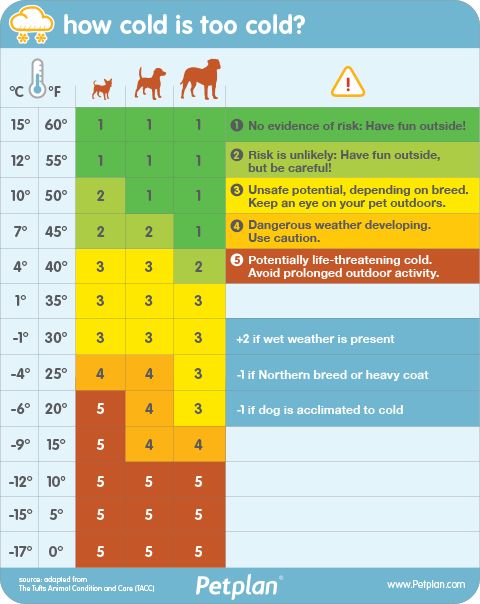
A good rule of paw is if it feels too cold for you, it’s probably cold to your pet. But if you’re looking for more specific guidelines, check out this chart created by Petplan’s veterinarians.
Every winter it’s the same. I insist on suiting up my pups in cold-weather gear when temperatures go below freezing, while my husband maintains that the coat nature gave them is sufficient.
Who is correct? It depends.
Breed, body size and environment all contribute to a pet’s risk factors for frostbite and hypothermia. Dogs with double coats like Siberian Huskies and Malamutes don’t need coats—in fact, in some cases, a coat could lead to them overheating. For these pets, 20˚F can be perfectly safe. But smaller breeds and those with thin coats fare worse in winter weather. Temperatures in the teens and twenties can be potentially life-threatening to them.
People don’t always realize the danger winter weather can pose to pets. Extreme temperatures can cause everything from arthritis flare ups to skin problems to potentially deadly hypothermia. Factors like whether wet weather is present, how acclimated a dog is to cold conditions, a dog’s age and the thickness of his coat also affect tolerance for frigid weather.
It’s important, especially in households like mine with different dog breeds (Monty’s an English Toy Spaniel while Hermes is a Weimaraner), for pet parents to assess the safety conditions for each individual pet before venturing out in the cold.
Here are some other ways to give common winter pet health hazards the slip:
de-icers
Use a pet-friendly de-icer on walkways to protect your furry friend’s feet from caustic agents. Be sure to give paws a good wipe down or a dip in warm water once pets are back inside.
snow + ice
When snow covers scents and visual landmarks, off-leash pets have a hard time finding their way back home. Avoid unleashed play until the bulk of the snow has melted. NEVER let pets play on frozen lakes or ponds.
darkness
Since winter walking often happens in the dark, be sure both you and your dog wear reflective gear so you’re visible to motorists.
low humidity/forced heat
Winter brings out the worst in pets prone to dry skin. Using a humidifier and moisturizing leave-in conditioners can help. Ask your vet about adding omega-3 fatty acids at mealtime.
hypothermia + frostbite
Sometimes it’s simply too dangerous for pets to be outside, regardless of their breed. Protect your pet by always bringing him inside during extreme cold. Frostbite can happen in a matter of minutes.
A good rule of paw is if it feels too cold for you, it’s probably cold to your pet. But if you’re looking for more specific guidelines, check out the chart above created by Petplan’s veterinarians, or click here.
Plunging temps and wintery white stuff can be a blizzard on pet health. When winter comes knocking, keep furry friends healthy and safe by taking the proper precautions. And no matter what any chart says, if you feel an extra coat is appropriate, don’t let anyone—even a grumbling husband—talk you out of it.
